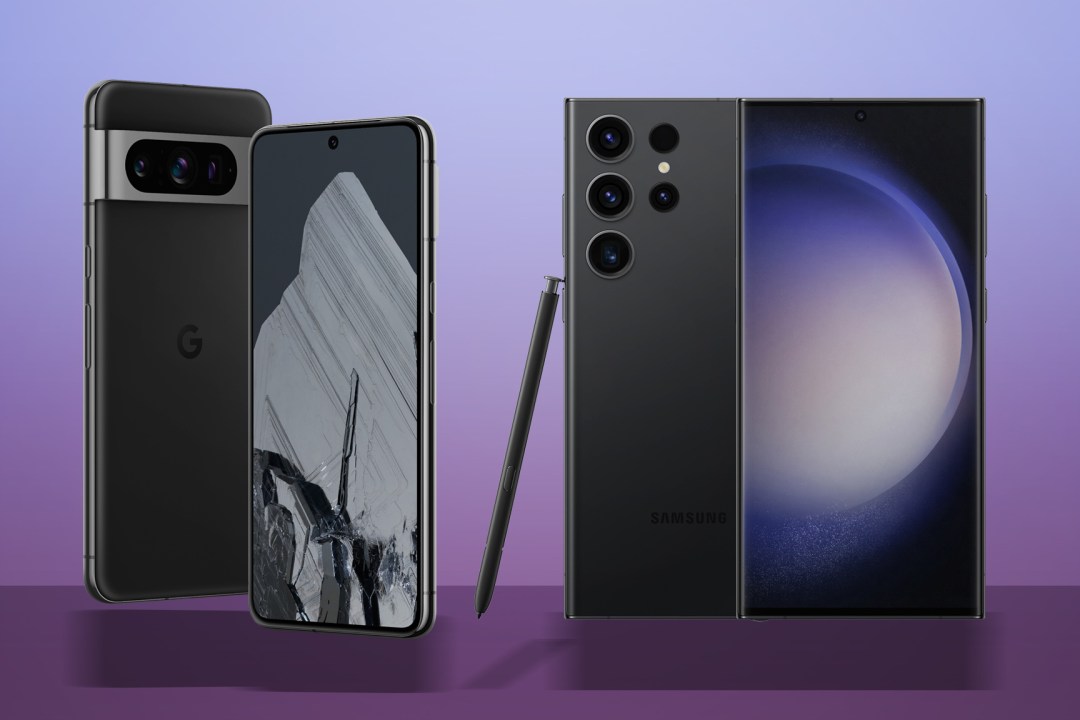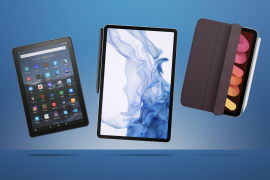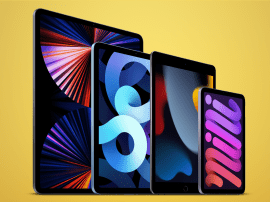Google Pixel 8 Pro vs Samsung Galaxy S23 Ultra: which is best?
Google takes on Samsung's best Android effort. Who takes the crown?

If you’re all-in on Android, picking the best smartphone each year usually tosses up the same few familiar names. For 2023, those are chiefly Samsung and Google. As the latest pair to duke it out, all eyes are on the Google Pixel 8 Pro vs Samsung Galaxy S23 Ultra to see which is more deserving of your cash.
Samsung’s flagship has been around for longer, but doesn’t skimp on camera hardware and delivers outstanding performance. It’ll also set you back $1199/£1249. The $999/£999 Pixel 8 Pro is more interested in AI, makes a bigger design leap forward than its rival, and arguably does more with less on the photography front. For all of the finer details, take a read of our dedicated Pixel 8 Pro review. But if the question of Google vs Samsung has you torn, then read on.
Design & build: heart of glass


Samsung settled on a consistent design for its smartphones last year, meaning the Galaxy S23 Ultra isn’t all that different from its predecessor. It’s still a sizeable handset, with a 6.8in curved edge display protected by Gorilla Glass Victus 2 glass. The glass and metal sandwich can be had in Phantom Black, Green, Cream and Lavender colours – plus Graphite, Sky Blue, Lime and Red options if you buy directly from Samsung’s web store.
There’s still a slot at the bottom to hold an S Pen stylus, which remains one of the S23 Ultra’s defining features. At the back things are kept simple, with individual cutouts for each of the phone’s four camera lenses.
Google was more willing to mix things up for the Pixel 8 Pro, swapping curved edge glass for a flat display panel. At 6.7in it’s smaller than the S23 Ultra, but not by a lot. The rear glass now has a matte finish, which should help hide fingerprint smudges better than the glossy Pixel 7 Pro did, and the phone’s corners have been rounded off more significantly than before. Google has also tidied up the rear camera shelf, with a single oblong cutout containing all three lenses. You can have one in Obsidian, Porcelain or Bay colours.
Both phones are IP68 dust and water resistant. Both have in-display fingerprint sensors. Neither has a 3.5mm headphone port, or supports microSD expandable storage.
Screens: battle of brightness


Both the Pixel 8 Pro and Galaxy S23 Ultra have vibrant, colourful AMOLED displays with epic amounts of contrast. Each phone can use LTPO panel tech to adjust their refresh rate from 1-120Hz, for smooth scrolling and motion when you need it and lower power consumption when you don’t.
With a 3088×1440 resolution, the S23 Ultra’s 6.8in screen delivers a pixel density of 500ppi. The Pixel 8 Pro has fewer pixels, at 2992×1344, which results in fewer pixels per inch. That means the Samsung is the more detailed handset on paper, but unless you break out a microscope you’re unlikely to spot the difference.
Brightness is where the gap widens. The S23 Ultra can deliver 1200 nits in High Brightness Mode (HBM) and as much as 1750 nits peak, which is plenty for outdoor use – but the Pixel 8 Pro promises 1600 nits for HDR content and 2400 nits in High Brightness Mode (HBM).
Performance & battery: all about AI
Google says the Pixel 8 Pro’s Tensor G3 processor is a big deal. It’s made on a 4nm process, which should make it more power efficient than last year’s chip, and has swapped to a 1+4+4 core layout that promises more oomph in apps and games. Naturally it’s still optimised for AI and machine learning, just like previous Pixel efforts. Paired with 12GB of RAM and either 128, 256 or 512GB of storage, it should feel perfectly responsive for a 2023 flagship phone. US shoppers will be able to buy a 1TB model too.
If early benchmark scores are to be believed, though, Samsung will retain its performance edge – despite being many months older. That’s because it partnered with Qualcomm on a bespoke version of the Snapdragon 8 Gen 2 processor, which runs faster here than on any rival phone. It’s the yardstick with which all Android rivals are measured, with apps and games running all but flawlessly. Storage options start at 256GB and include a 1TB model if your budget is big enough. All versions have 12GB of RAM.
Both the Pixel 8 Pro and Galaxy S23 Ultra have large 5000mAh batteries , which promise all-day battery life between charges. Google actually claims a 5050mAh cell, but with 100mAh of variance between individual handsets there’s very little in it.
Samsung has Google licked when it comes to wired charging speeds, though. While the Pixel only supports 30W over USB-C, the S23 maxes out at 45W, meaning less waiting at the mains for a full charge. Google does claw things back when it comes to wireless charging, managing 23W on a compatible charging pad to the Samsung’s 15W.
Cameras: which zooms best


Samsung went for a “more is more” approach for the S23 Ultra’s camera setup, with four separate shooters headlined by a giant 200MP main sensor. Pixel counts are more mainstream everywhere else, but two 10MP telephoto lenses with optical image stabilisation supply 3x and 10x optical zoom abilities. The 12MP ultrawide doesn’t disappoint either. It’s a fantastic performer in all lighting conditions.
Google has stuck with three sensors for the Pixel 8 Pro. The 50MP main camera and 48MP telephoto keep the same pixel counts from last year, but the ultrawide has made a big jump to 48MP. It still has Macro Focus abilities for close-up shooting. All promise better low-light performance. Google’s Super Res zoom algorithms can take the 5x optical zoom lens much further with minimal image quality compromises, and low light performance remains stellar.
An AI-based Best Take mode joins Magic Eraser as Google’s headline software features, using multiple frames to swap faces so everyone in the shot is smiling and not blinking. It’s a bit creepy if you ask us.
As to which takes the best photos? As impressive as Samsung’s 200MP sensor is, Google’s image processing goes an awful long way – and might be enough to swing it in the Pixel’s favour.
Google Pixel 8 Pro vs Samsung Galaxy S23 Ultra initial verdict

At the time of writing, the Galaxy S23 Ultra is a proven entity: Samsung’s top-tier smartphone takes outstanding photos, is seriously powerful, and has the benefit of S Pen stylus support. It’s particularly pricey, but because it has done the rounds for the best part of ten months there are tempting deals to be had when shopping around.
The Pixel 8 Pro, on the other hand, is more of an unknown. The Tensor G3 processor is meant to be more power efficient, but we’ll only know for sure if the previous generation’s battery and thermal issues have been resolved. Minor hardware upgrades aside, the camera focus has very much been on AI assistance and new software shooting modes. And while a super bright screen sounds great, we can’t vouch for picture quality.
Perhaps Google’s Android optimisations and camera image processing will make all the difference.



